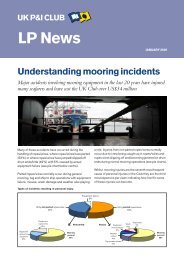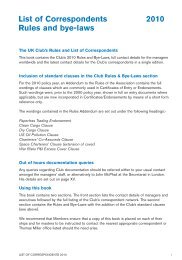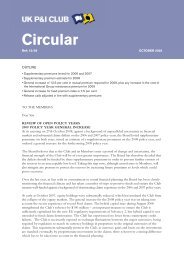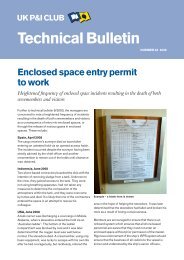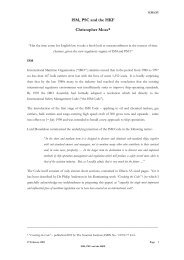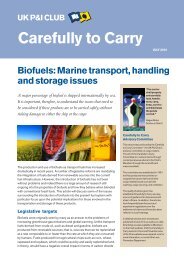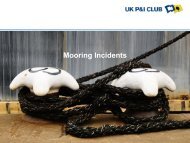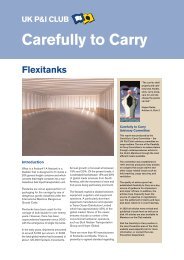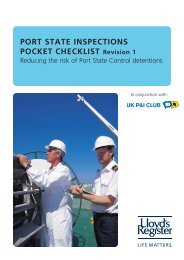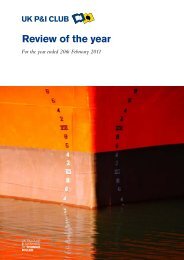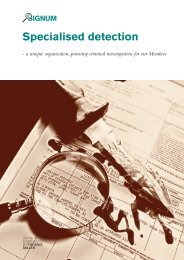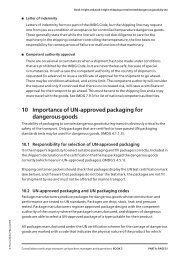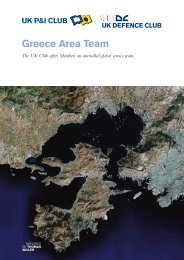Bulk Matters - UK P&I
Bulk Matters - UK P&I
Bulk Matters - UK P&I
You also want an ePaper? Increase the reach of your titles
YUMPU automatically turns print PDFs into web optimized ePapers that Google loves.
Occasionally, surveyors report a ‘negative’ stores<br />
variable which is theoretically impossible unless, in<br />
extremely rare instances, the vessel had been<br />
subject to modification, and large quantities of<br />
structural steel removed, without being subject to a<br />
further inclining experiment and commensurate<br />
correction of the relevant data contained in the<br />
vessel’s stability book.<br />
Charterparties often contain reference to an<br />
approximate quantity for the vessel’s ‘constant’,<br />
which may well create a discussion between master<br />
and surveyor should the constant found by survey to<br />
be substantially larger than that quoted by the<br />
owners. The surveyor, after relevant checks, should<br />
remain confident in the figure obtained, but always<br />
record on documents issued to the master and<br />
clients, any unusual factors or difficulties<br />
experienced during survey. These include any<br />
differences between surveyors, should owners,<br />
charterers or shippers each appoint separate survey<br />
companies to act on their behalf.<br />
Documentation<br />
●<br />
●<br />
●<br />
At completion of survey, a ‘survey work sheet’ or<br />
computer printout should be placed on board the<br />
vessel recording the data and calculations used to<br />
obtain the cargo loaded / unloaded quantity. This<br />
document is usually produced by individual survey<br />
companies, or by shipping companies for use by<br />
their officers.<br />
A formal ‘survey report’ should be submitted to<br />
clients at a later date. Specific formal documentation<br />
has been drawn up, amongst others by IMO, United<br />
Nations Economic Commission for Europe and<br />
various P&I Clubs.<br />
The formal report document should not only include<br />
details of the survey, but also:<br />
●<br />
●<br />
●<br />
●<br />
●<br />
●<br />
●<br />
Dates and times of surveys<br />
Vessel particulars<br />
Ship’s location<br />
Weather conditions (and whether these were<br />
within acceptable limits)<br />
Sea conditions (and whether these were within<br />
acceptable limits)<br />
Tidal/current conditions (and whether these were<br />
within acceptable limits)<br />
A record of any difficulties or defects in a ship’s<br />
documentation or equipment which might cause<br />
the calculated weight by draught displacement<br />
survey to be outside acceptable limits of normal<br />
draught survey measurement error.<br />
Expert opinion<br />
Surveys must be carried out to the very best of the<br />
surveyors’ ability, with each part of the survey<br />
conducted as accurately as possible in order to<br />
minimise procedural and/or measurement errors which<br />
could effect the quantity of cargo recorded by survey as<br />
being loaded or discharged.<br />
The final report should include details of any defect or<br />
circumstance regarding weather, surface water, tides /<br />
currents or on board conditions which the surveyor<br />
considers might well influence the result adversely.<br />
Cumulative errors<br />
● Errors can occur when reading and correcting the<br />
draughts. The final fully corrected 3/4 mean draught<br />
should be within +/- 10 mm of the true mean<br />
draught.<br />
●<br />
●<br />
●<br />
Errors of calculation. The main error to be avoided in<br />
this section is that of incorrectly positioning the LCF<br />
relative to LBP/2 the amidship point.<br />
Error of the water density in which the vessel is<br />
floating. Always ensure an average sample, or<br />
alternatively the average of a number of water<br />
samples are obtained and the correct type of<br />
certificated hydrometer is used to obtain the density.<br />
Sounding of tanks. Leaving aside documented<br />
tables which may not be accurate, the way of<br />
avoiding the main errors in this section of the survey<br />
is by ensuring, as best possible, that all volumes of<br />
liquids, especially ballast water, on board are both<br />
correctly quantified and attributed with correct<br />
densities. These factors, particularly when applied<br />
to ballast water, undoubtedly contribute to the<br />
largest number and degree of errors likely to be<br />
encountered in draught surveying.<br />
Bearing these reservations in mind, a well conducted<br />
draught survey under reasonable prevailing<br />
conditions is capable of achieving an absolute accuracy<br />
of +/- 0.5%.<br />
See following pages for a worked example<br />
A full version of this article is available in the Loss Prevention –<br />
Carefully to Carry section of the Club website, www.ukpandi.com,<br />
under Miscellaneous – Measurement of bulk cargoes<br />
24




